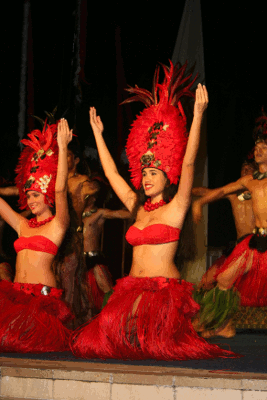|
Saturday 2nd July 2011 After a slow final few days sail from the Marquesas, we finally arrived at Kauehi in the Tuamotus. The Tuamotus comprise of a hundred or so small atolls that are spread in a NW to SE direction between the Marquesas and the Society Islands. We're anchored just off the small town in the north eastern corner of Kauehi and it's a tropical paradise. Beautiful white sandy beaches, amazingly blue waters that vividly change shade as the water shallows toward the shore. Palm tree studded beaches where the palms wave gently in the warm breeze and beckon you to come and sit a while, just enjoying the peace of this island paradise. |
||||||
|
We picked Kauehi as our first landfall - we'd been told it had a nice wide entrance and an easy approach through the channel and into the town. Many of the atolls have lots of shallow reefs inside and can be quite tricky to navigate. Easy is good for us and we'd also heard that Kauehi is as beautiful a place as you'll find anywhre in the Tuamotus. While we can't wait to get ashore and have a look around, for now we're contented just to chill out on “Connect4”, pack away all the mess that seems to accumulate when you're on passage, just generally take things slowly, oh and pump up “Willie” our dinghy that now seems to be going flat on a regular basis. Over the last few days we've had to take to lifting him out of the water on the evening, because if we leave him in the water overnight, when morning comes, he's totally deflated and the hard bottom is full of water. |
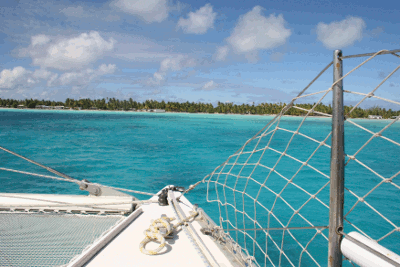
|
|||||
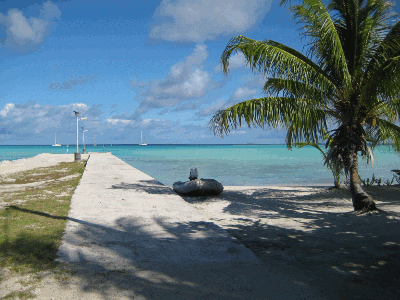
|
Cheryl and I enjoyed a nice afternoon relaxing, reading and we even treated ourselves to a glass of our cheap “Clos” carton wine we bought in the Panama, something we've chosen not to indulge in while on passage. We tried the video camera again today, but sadly it seems to be getting worse. Whereas last week we could get the camera to play back using the remote control, now none of the remote control functions work. I managed to get around this by starting the play back from the DVD studio software that I use for dubbing the tapes, but it's not boding well for this camera – I think the swim last month really did some damage. |
|||||
|
We heard from some friends onboard “Galilea”, who we've not seen since the Galapagos. They're in the same anchorage as us and it was so nice to see their smiling faces again. Like us, they're on a catamaran, but had an unfortunate incident in the middle of the Pacific Ocean when they lost one of their rudders. Fortunately, they made it to the Marquesas without further incident where they managed to fabricate a temporary replacement at the local army base. Some days it's nice to be on a catamaran where you have two rudders; “Galilea” were almost unaffected by losing one rudder and only needed to sail a little slower than usual. As they're both French they'll be a great help with the local language as here they all the islanders speak either Tahitian or French, neither of which we're very strong in. “Galilea” told us that there was a triple feature movie screening tonight in the town hall. Locals were making food and drink to sell and we were all welcome to come and enjoy the night. Not sure if it would be in English, we decided to go along anyway, if nothing more than for the atmosphere and the chance to mingle with some locals. Natacha on “Galilea” made a cake and Cheryl made some chocolate balls for the food stall which were a great hit. We couldn't understand the movies, but had fun chatting with “Galilea” and just enjoying our time ashore in this beautiful island before going back to “Connect4” and falling asleep for our first uninterrupted night's sleep in nearly a week. |
||||||
|
Sunday 3rd July 2011 Kuaehi had a nice little white and blue church in the middle of the town, so we got up early, got dressed and rode our leaky dinghy ashore. As people were walking or driving to church, we were dragging our dinghy up the sandy beach so that it wouldn't sink by the time the service was over. The whole service was in Marquesan, so we couldn't understand a word of it, but the singing was nice and there was a cute little girl in front of us who kept looking around and smiling at us – one of the joys of being the only white people in a small church. At one stage the minister switched to French and from the gist of what he was saying I figured he was talking to us. I poked Cheryl and said to her “I think they're saying hello to us”, just as there was a little chuckle from the congregation and the man in front of me turned and said in broken English “Did you understand? He has just thanked you for coming to his church and wished you enjoy the service”. After the service was finished, a man, who we later discovered was the town mayor, and also the supermarket owner, came up to us and in broken English enquired if Cheryl was the person who made the chocolate balls for the movie night. He seemed very pleased that she had and congratulated her on her skills then asked if she might make some for him as well as he was arranging a birthday party for his wife and thought they would make a wonderful treat. Cheryl quickly agreed and we all had a bit of a chuckle over it as we walked back to the beach, to find “Willie”, lying on the beach, flat as a pancake. We pumped up the dinghy and then quickly launched it, hoping to make it back to “Connect4” before it went flat. No sooner had we put the dinghy in the water than Nick noticed a stream of bubbles, rather large ones, issuing from the back of “Willie” - I really have to get onto fixing the dinghy! It's bad enough having to beach the dinghy so that it doesn't sink, but returning to find it flat on the beach is just embarrassing. Monday 4th July 2011 Along with “Galilea” we headed off to visit the Kuaehi Pearl Farm to see how they make the much sought after black pearls. Having “Galilea” along was very helpful as, being French, they could help translate what our guide was saying. The pearl farm guide was no other than the Mayor, who is also the supermarket owner and as we found out, the owner of the pearl farm we visited. It seems like this guy has a finger in every piece of pie on the island. We were just commenting between ourselves as he drove us out to the pearl farm, in the back of his truck, when he pulled off the road and entered a building site. He explained to us that he was supervising the construction of a new house for some foreigners who were shortly moving to the island – I guess there's nothing that this guy can't do. |
||||||
|
Sadly our video camera is getting worse by the day. Today we noticed that we can't rewind, of fast forward and now that when we record, after a couple of seconds of recording, the camera switches into playback mode. We've also noticed that Cheryl's still camera is starting to deteriorate. The screen on the back of the camera now looks like you're viewing it through a layer of water – perhaps we are. The pearl farm was fun to see, but I was a little disappointed to see the size of the implant they put into the pearls. From what we could see, and from what we were told, the pearls are grown for only 6 months inside the oyster, so I guess the pearl |
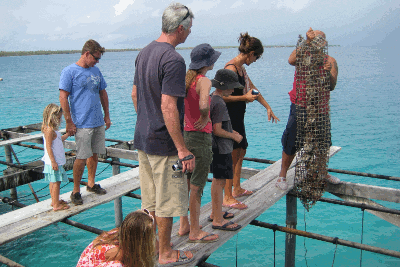
|
|||||
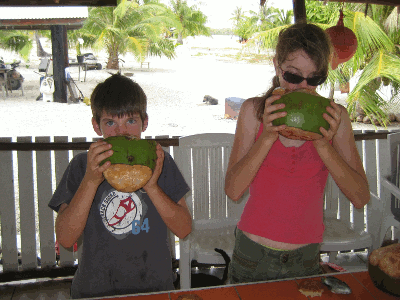
|
coating is very thin. Perhaps the more expensive pearls are grown for much longer than this, and hence have a much thicker covering, but these were pretty thin. All the same, it was very interesting seeing how the pearls are produced. While we were at the pearl farm, we were given refreshments of coconut milk and some traditional flat coconut bread which was deep fried and tasted divine. |
|||||
|
Tuesday 5th July 2011 Today we pulled anchor and motor sailed the 20NM from the northern end of Kuaehi to the southern end of the atoll. Half way there, we passed our friends Peter and Sandra on “Bondi Tram”, another Aussie yacht, heading north – we aren't taking it personally that they'd been there for a week, but now we're arriving they're leaving, at least not yet! That night we went ashore with “Galilea” and had a small bonfire where we cooked sausages, potatoes and then roasted marshmallows as we watched the sun set over the beautiful Pacific ocean. Days like these make you feel glad to be alive, they make you feel so privileged just to be a part of such a beautiful world. After all the marshmallows were eaten and the fire put out, we pumped up “Willie” and paddled back out to “Connect4”, tired, dirty but contented. |
||||||
|
Thursday 7th July 2011 Taking “Connect4” through a narrow, shallow pass with reefs on either side and knowing that if I get the timing of slack tide wrong, I could easily have a 5-6 knot current running makes me nervous. I'm a conservative sailor and I like the odds stacked well and truly in my favour. Leaving South Kuaehi for |
||||||
|
Fakarava I checked and double checked the tide times, I watched the channel for signs that the current was slackening and when I was sure everything was right, we headed out towards the channel entrance, only to be hit by a huge deluge of rain and wind. Some days, no matter how much planning and care you put into an activity, mother nature thwarts it with a small move. Such was today. We motored hard into the rain and wind and as we got to the pass, there was still a current of 2-3 knots running against us. This current, although not dangerous to “Connect4” set up a series of small sharp waves and swirling water that made us buck and bounce as we went through the channel and out into the ocean. Once through the channel, as if of queue, the wind died down, the rain stopped and the sun came out again. |
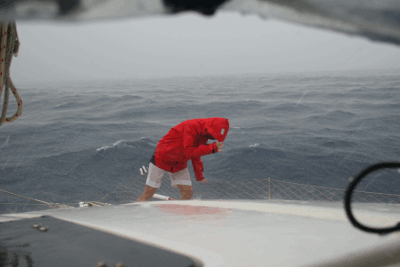
|
|||||

|
The sail to Fakarava was pretty uneventful and we arrived in time to drop anchor then go ashore for a look around before it got too dark. This tuamotu is amazingly pretty and for me anyway is the epitome of the much dreamed of “islands in the sun”. The people are friendly, the island is pristine and it's always warm and beautiful. The only thing that let us down was “Willie” our leaky dinghy. After anchoring “Connect4” we went to launch the dinghy only to discover that it was totally flat – again. It was so flat that I had to hang over the back of “Connect4”, pump in hand and half inflate the dinghy so that I didn't sink it when I lowered it into the water. We all feel that “Willie” just isn't getting with the program of cruising and is becoming a bit of a let down. Something needs to be done – lets face it, if it was a horse, it would have been shot long before now! |
|||||
|
North Fakarava is going to be remembered at the place that we had to start pumping “Willie” enroute. We set off early in the morning to go ashore and were barely 400m from “Connect4” before we noticed “Willie” was sinking! Well not quite, but we were getting that soggy sinking feeling as the inflatable sides started collapsing around us. A bit like when you sit on an air bed in the swimming pool and then pull the plug – it's not long before mattress starts wrapping around you and you get the feeling that if you don't get off soon then you're going to get wrapped up in it and sink. Yep – we were there! Quickly we got out the air pump (an essential piece of equipment we started carrying with us a few weeks ago whenever we ventured out). We all took turns pumping as we motored quickly to shore. Ok - “Willie” is getting terminal now. Up until now, the biggest problem we had was that we couldn't do without the dinghy for 48 hours while we waited for the glue to dry. Now I think we're just going to need to do it. |
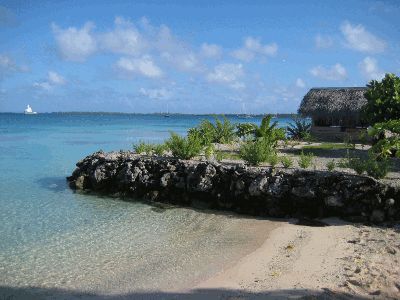
|
|||||

|
Fortunately for us, “Galilea” were nearby and very generously offered that they would be happy to play ferry for us whenever we needed to go ashore, while the glue dried. We took the opportunity and hauled “Willie” up on the bow of “Connect4” using the spinnaker halyard. Once there, I deflated what was left of the air in the dinghy – it really didn't take long, then set to the task at hand. I laid out the glue and hardener. I cleaned a nice large area around where the patch was to go. I tested the position of the patch. I even read the Turkish instructions on my dinghy repair kit. I was set to give “Willie” a new lease of life. I opened the new glue container and to my horror found that it had gone hard – AAARRRGGGHHHH!!! Fakarava isn't quite a mecca of yacht chandlers, so after all my efforts we'll still have to persevere with a leaky dinghy for a while longer. |
|||||
|
Saturday 9th July 2011 We motor sailed to South Fakarava today and we're starting to get a bit of a complex around “Bondi Tram”. On our sail down south, “Bondi Tram” once again passed us going in the opposite direction. Perhaps we should start washing a little more frequently? South Fakarava, simply put, was breathtaking. From the moment we dropped anchor between the coral reefs and took our first look around, we knew we were in an special place. Because there were so many reefs and coral “bommies” about I dove to set the anchor by hand. We anchored in about 5m depth and while I was underwater placing the anchor where I wanted it, I noticed a dark shape moving about behind me. I turned in time to see a shark circling me. That just about did it for me. The anchor was set in 30 seconds and I was back onboard “Connect4” in about 35 seconds! I really don't like sharks. Being an Aussie, we live our life in constant awareness of sharks and although they don't normally attack humans, we like to keep a good distance between ourselves and them. Simply put, if they're in the water I prefer to be on the land. |
||||||
|
In the evening we went ashore to one of the nearby motus to have an explore and to have a small bonfire. We got within about 100m of the shore and realised that we were in the midst of a shallow coral area, so we had to stop the outboard and paddle in by hand so that we didn't damage the coral or the outboard. Now have I mentioned that “Willie” the dinghy has an issue holding his air? Yep, you guessed it. We'd pumped him up before we left “Connect4” and anticipating a quick trip into shore we figured we could make it without going flat. Now we needed to paddle, the trip took a little longer than predicted, so you guessed it ... while Cheryl and I paddled our way to shore, Chelsea and Nick were kept busy pumping. Safely ashore, we explored this gorgeous little motu as the sun started to set then lit our fire and enjoyed some quality family time. |
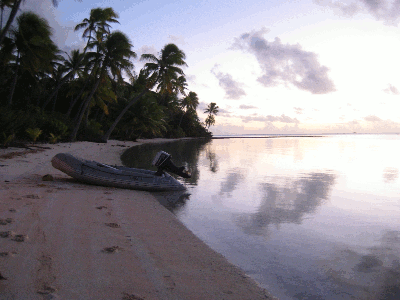
|
|||||
|
The evening was perfect as we relaxed on a little island all of our own. We watched the hermit crabs come out and explore the waterline and we listened to the sounds of the palm trees and the forest behind us. As the evening wore on, we sat, oblivious to the storm clouds gathering above us, until they broke and we got drenched. We hastily packed up our little camp and raced back to “Connect4” looking and feeling like drowned rats. But it didn't matter, because we were happy. We are a great family. |
||||||
|
Monday 11th July 2011 Yesterday when we were ashore walking around, we met a lovely lady called Annabelle who runs a small resort with about 5 small individual huts located just inside the pass. We got talking and she invited us to join her for breakfast the next morning on her balcony overlooking the beautiful reef. |
||||||

|
We had a delightful breakfast as we talked and she told us about her island and her efforts to try to protect the southern island from development. She's very much into protection and preservation of the natural beauty of Fakarava and she's made a point of installing solar panels for her electricity requirements and uses rain water for most of her cooking and drinking and bore water for everything else. As we talked, she shared with us some of the problems she faces, predominantly that the government of the island isn't interested in helping her financially or otherwise to preserve the south pass, so she relies on help from visitors to the island. She has a number of sponsors, including Bill and Melinda Gates, who visit regularly, however they must be careful that they're not seen to be giving money to her work. |
|||||
|
One problem that Annabelle has at the moment is with where some cruisers anchor. Some yachts are anchoring right over the coral reefs and because of this, they're damaging the coral with their anchors and chain. I agreed to put together some wording for a sign, that Annabelle will get made by one of her sponsors in Hong Kong, requesting yachts not to anchor in the reef but referring them to another more suitable anchorage that is nearer to the island. Annabelle's husband will build a small dinghy dock for these yachts that use the preferred anchorage. Another project that I discussed with Annabelle was water power generation. Every time the tide swings in the lagoon, a current of 6-7 knots flows through the channel. This water flow could easily spin a turbine and create reliable power for the huts; they've already done a current flow profile of a section of the channel which I could use to determine the turbine size, so it looks like this could be something I could contribute to the island. |

|
|||||
|
After breakfast we took the plunge into shark infested waters and drift snorkelled through the pass with the incoming tide. Drift snorkelling is basically lazy man's snorkelling where you motor out through the pass in the dinghy, then hold onto the sides of the dinghy, snorkelling, as the current drifts you back through the pass. We motored out and donned out diving gear as we looked out into the crystal clear waters of the pass, gazing over the amazing coral formations that line the sides of the pass. The water was so clear that |
||||||
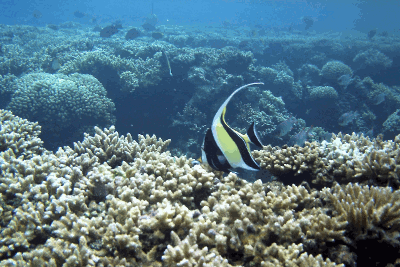
|
we could easily see the five or six reef sharks that were swimming near our dinghy – and therein was the problem. No matter how many times we'd been told that these sharks weren't particularly aggressive towards divers, it's still a very unnatural action to put yourself into the water when you can see fins breaking the surface and circling! Each of us delayed for as long as we could, hoping the other would go first, thus diverting the attention of the sharks. In the end we all took a breath, each secretly hoping it wouldn't be our last, and plunged into the azure waters to be rewarded with breathtaking views of the brilliantly coloured coral beneath the water. The coral, the fish and the vibrancy of the coral was indescribable. Everywhere you looked, the reef was alive with brilliant colours of blues, greens, reds and yellows. Fish were everywhere and wherever you turned or looked, there was always something happening that would catch your attention. The current drifted us through the channel, past the tiny dock and under the skirt of the restaurant where we'd had breakfast barely an hour before.
|
|||||
|
Beneath the restaurant we could a school of large fish, who appeared to be hiding in the shade of the restaurant floor, watching us as we watched them. We saw a Neapolian fish, which was as large as Nick is long, lazily making its way across the reef. As we left the channel and drifted over shallower water, our drift speed increased until it felt like we were on an aeroplane, flying across the top of the coral watching reefs, fish and sea creatures zoom by underneath us. All too soon it was over, but we'd had so much fun that we climbed back into the dinghy and motored out for another turn. As for the sharks … I now know how a mouse feels when he's put into a pythons cage. At first he's scared and keeps an eye on every move the snake makes. After a while he gets a bit blasé about the snake's presence and starts going about his activities almost without care … right up until he turns into snake dinner. For me, when I first got in, I was watching every move every shark made as I nervously made my way through the channel. After a little while, I realised that to a large extent the sharks are pretty much not interested in us being in the water with them. Don't get me wrong, there was always one or two that would take pleasure in circling around behind you to come in for a slightly closer look the way a street dog might watch you go by, then come around behind you for a sniff as you walk down his street, but for the most part I was surprised how quickly I got used to swimming around the sharks. |

|
|||||
|
“Willie” our infamous dinghy however wasn't doing so well. Yesterday we tied it to the back of “Connect4” while we ate lunch. Figuring we'd only be ½ hour we just left it attached on the long painter. Cheryl went out of deck just after lunch and suddenly was jumping up and down and yelling for me to come on deck. I got up on deck to see “Willie” almost totally deflated and nearly sunk with the weight of the outboard pulling it down. The floor was awash and the poor long suffering outboard engine was almost submerged to the engine cover. We quickly rescued the outboard and pumped up the dinghy, however when I started the outboard it appeared that I had a hole in the exhaust pipe – the outboard sounded like a lumpy hotrod. The engine started and ran for a couple of seconds, then died. I took off the engine hatch to check everything was alright and then put the cover on and tried again. The engine started again, ran for 5-10 seconds then died. I decided we had a problem, so I took the outboard off and carried it up onto the deck of “Connect4” where I took off the cover to have a closer look. The engine started again and ran beautifully, so I turned it off, put the cover back on and bolted it back onto “Willie”. I started the engine again and it ran for 5-10 seconds then died. This was getting a little strange! I took the cover off again and started it and this time ran perfectly. Scratching my head I put the cover back on, only to have the engine splutter and die not 10 seconds later. I took the cover off and had a close look at where the cover clipped down to make sure that I wasn't pinching the fuel line of bending any wires, obviously putting the cover back on was the culprit. I couldn't see anything amiss, so this time I started the engine without the cover on and slowly lowered the cover onto the engine. When the cover was about ½ cm off the engine I noticed the engine starting to run a bit rough and threatened to stall. I quickly took the cover off and the engine idled nicely. Then it dawned on me! The hole in the exhaust was letting exhaust fumes out into the engine cover which were working their way up to the air intake and choking the engine. Problem sorted, well partially. Until I can dismantle the engine and take out the holed exhaust pipe, then take it somewhere to be welded we'll just have to run with the engine cover off. Poor “Willie”. Not only do we have to pump the dinghy up every 5-10 minutes of travel, we also have to take the engine cover off to run the outboard, which now sounds like a tractor. We're going to be the embarrassment of the anchorage. The leak is now so bad that half way through our drift snorkel I had to grab the now almost permanently attached pump and pump it up again. |
||||||
|
Tuesday 12th July 2011 Leaving Fakarava for Papetee, Tahiti, a three day two night passage. I have to be honest, after the highs of Fakarava, we're all feeling flat, tired and over the whole “sailing thing”. Night watches are a drag and I don't like the first few days at sea where we all feel a little sea sick and off colour. I'm tired of broken sleep and much prefer curling up with Cheryl in my arms rather than falling asleep on my own. We tried the video camera today and the slow death is continuing. Now the record button refuses to work, so I guess that's pretty much the end of the camera's usable life. Cheryl's digital camera that also went for a swim is hanging in there, although the screen looks like you're viewing the scene underwater. Hopefully it'll continue to hang in there.
|
||||||
|
Oh, one more thing. How do you know you're on a cruising boat? Easy! You know you're on a cruising boat when you have to move the washing to get to the helm. |
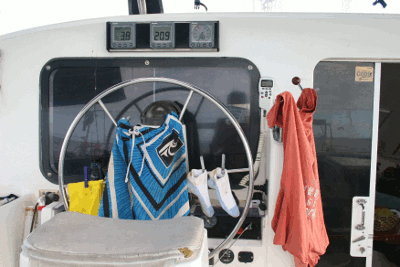
|
|||||
|
Tuesday 14th July 2011 Tahiti for us will always be remembered as a place we went to for work. Papetee, the principle city in Tahiti was one of the few places in this part of the world where we could get boat jobs done, so we set to with a vengeance. We hunted down chandleries, somewhere to get the outboard's exhaust pipe repaired, parts for the yacht, replacement rope for old ones that had chaffed through in the crossing, and so on and so on the list went. The first trick we faced through was getting ashore. We were on a borrowed mooring ball that was a fair distance from the pier in the yacht club where we were allowed to leave our dinghies, however the big problem was that there wasn't anywhere that we could beach “Willie”, only tie up. Any more than 30 minutes away from him and he'd sink! Fortunately, Ken and Wendy on another Australian yacht called “Cosimo”, who we'd just met on our way in, offered to loan us their spare dinghy for a few days. This was such a generous offer, as it would allow us to get ashore to buy the glue to repair our dinghy, then to leave it for 48 hours while it set. We gladly accepted but were warned that it was an old dinghy, with a soft bottom and that it also had a small leak. Not having any options, and grateful for the offer, we were very happy to accept the dinghy … any dinghy. Ken dropped it off to me and I set about inflating it, no small task when you have to pump from totally empty. I eagerly launched it, then went back inside to rouse Cheryl so I could get a hand to fit the outboard and go ashore. As I went back on deck in preparation of fitting the outboard, I noticed the sides of the dinghy were already losing shape and softening – this wasn't a good start! We had a quick conference and decided that it would be better not to fit the outboard, but rather to row so that if the dinghy sank at the dock at least the outboard wouldn't go with it. We all piled into the small borrowed dinghy and set off towards shore, a 20 minute paddle by our estimates. 10 minutes out we knew we were in trouble, the dinghy wasn't going to make it! The borrowed dinghy was losing air faster than we could paddle and as it had a soft bottom, the whole dinghy was closing in around us much like an air bed wraps around you when it goes flat in the pool. Imagine 4 people paddling furiously in a small dinghy that's folding up around them and slowly sinking and you'll get the picture. Fortunately for us, “Cosimo” who were going ashore at the time, came by and offered to give us a tow, thereby saving what could have been a terrible misfortune. |
||||||
|
In town we walked around and saw the sights before making our way down to the waterfront where the “Fruit Races” were about to begin. The “Fruit Races” consisted of different heats of people (men, women, children) racing a couple of laps around a course with two huge bunches of fruit suspended at each end of a large wooden branch that was slung over their shoulder. These loads of fruit looked heavy enough, without the heavy wooden branch that the competitors had to carry as well.
|
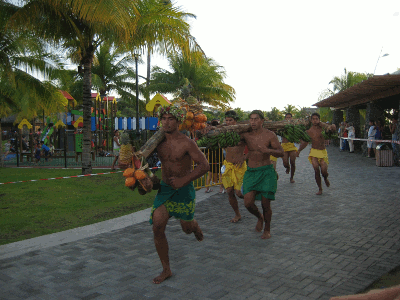
|
|||||
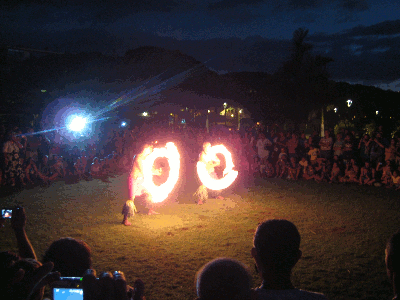
|
After the races were over and the sun had set, the music came out and we watched some traditional dancing as well as some fire dancing. It was fun just to hang out with the locals, enjoying the entertainment and the atmosphere of the place.
Pretty soon our stomachs started growling, so we hooked up with a few other cruisers and wandered down to a little street restaurant area where all sorts of tables and chairs had been laid out in what looked like a car park. Surrounding the area was a plethora of different street vendors selling all manner of meals. We bought a couple of plates of noodle dishes and sat down to a fine meal with good company. It was a great night out. |
|||||
|
Thursday 16th July 2011 The dinghy is fixed! Well at least the big hole is patched and appears to be holding air. I have high hopes that soon we'll be able to go ashore and not worry about the dinghy sinking on us. This week in town has been a week of festivities for Bastiles Day. The Tahitians have arranged various games and events, however finding them is proving to be very elusive as the man at tourist information never quite seems to know what is going on. Even when you show him one of his own brochures advertising an event in his town, he's still not sure if it's on and where it is. Several cruisers have had the same problem and we're not sure if he just doesn't know, or doesn't want visitors going there. Some friends were enquiring about a dance/singing competition that was being held that evening, but our man at the tourist information centre didn't have a clue about it – despite the fact that 4 hours later, after they'd found out where it was from other people, they were shown to their seats by none other than the tourist information guy. Go figure that one out? |
||||||
|
Sunday 18th July 2011 Since we were in an area with lots of other kid boats, we decided it was time to have Nick's birthday party since we were at sea on his real birthday. We found a suitable park and invited a couple of his friends and soon we had the makings of a grand birthday party. Cheryl baked a cake and made various other birthday treats while I wrapped the prize for the game of Pass-the-parcel. |
||||||
|
We loaded poor “Willie” to the gunnels with food, drink, chips and presents and started for shore. Half way in drama struck as the outboard died again. The sea was a little choppy, so perhaps we took some water spray into the carburettor since we were still running the without the outboard's engine cover on. Feeling very frustrated and vulnerable, we started paddling, careful not to wet our overloaded dinghy. As fortune would have it, our knights in shining armour “Cosimo” spotted up paddling and came to our rescue … again. They towed us to shore and helped us unload all the party goods.
|

|
|||||
|
The birthday party was a huge success and I think the parents had just as much fun as the kids. Cheryl's now world famous jelly slices were hotly contested and lasted only a few minutes and the party games went off well, despite only having a laptop and some tiny speakers for the music. Nick will always remember his 10th birthday party as being the birthday party he had here in Tahiti. |
||||||
|
Monday 19th July 2011 Have you ever had a day that really upsets you? Have you ever had a moment of reckoning where as a parent you have to act in a way that just breaks your heart? Have you ever had to do something that you know is right, but goes against everything you want to do as a parent? Have you ever had to hurt someone you love to help them? Today was my day, everything inside me was screaming “you can't do that to your son if you love him!”, but I did – and it broke my heart doing it. Nick was swimming at his birthday party with his friends yesterday. Unfortunately as he climbed out of the water his hand went down on a sea urchin and two of the spines went into his finger. It was his party and we didn't make a big fuss at the time. It wasn't hurting him too much, so we just left them until we got back to the boat. By the time we all got back, it was late and we were all tired. Nick in particular just wasn't coping and although we tried to convince him to let us clean out the needles, there was no way he was going to co-operate that night, so it had to be done today. I tried as best as I could to scrape away at the skin with a small needle (they don't have splinter probes here) but the spines from the urchin had gone in too deep and it was hurting Nick too much. We considered all the options and in the end decided the best plan was to give him some local anaesthetic to numb up his finger so we could get the spines out without trauma. Nick was brave with the thought of it, but once he saw the needle it took us almost ½ hour to distract him and convince him that this really was the best option. I could see how hard he was trying, I could hear him talking to himself, convincing himself that it would be ok, but everytime it came to holding his hand still he just couldn't quite manage it. It broke my heart to see the effort he was putting in, trying to be brave, trying to let me do what I had to do. We put on a movie and gave him some earphones as a distraction, but still when it came to holding his hand flat, it just wasn't quite impossible. The part that broke my heart the most was that he knew it was necessary and he knew it was for his own good, but he knew the needle was going to sting him initially. I knew the needle was going to sting. My hands were trembling when he mustered the courage and bravely held out his hand for me, telling me he was ready. This story has a happy ending though. The anaesthetic went in without fuss, he held still and I numbed up his finger without a flinch from Nick. When I told him I was all done, with a tremble in his voice he asked “Is the needle out yet?” The relief on his face was clearly visible as he braved to look at his finger to see that I had indeed finished. He played with his finger for the next couple of minutes as the anaesthetic took effect. Once the anaesthetic had fully taken effect, I was able to clean out all traces of the urchin, give the wound a good wash with antiseptic and then tape it up. Afterwards Nick commented that he hardly felt the needle at all. I pray I never have to do that to my son again. |
||||||
|
Saturday 23rd July 2011 Once again, we're on our way. In the background we can see Tahiti, slowly getting smaller as it merges into the haze of the distance. Off our port bow we can see the island of Moorea, its jagged mountain peaks touching the clouds, the multitude of lush green grasses, trees and bushes climbing from the island's edge to the ragged highlands of this tropical island. I've just finished reading the diaries of Captain William Bligh and his accounts and descriptions of these islands. If you ignore the wharfs, the roads and the modern buildings, it's not hard to picture the islands how they would have looked to Bligh and Fletcher Christian. The peaks are still ragged and imposing, the islands still green and fertile, the islanders still friendly and inviting. Until white man came, these islands were a paradise in the pacific, abounding in fresh fruits and plants, people without care who were described in Bligh's logs as “... their faces are never darkened with a scowl, or covered with a cloud of sullenness or suspicion. Their manners are affable and engaging; their step firm and graceful; their behaviour free and unguarded; always boundless in generosity to each other, and to strangers; their tempers mild, gentle and unaffected; slow to take offence, easily pacified, and seldom retaining resentment or revenge, whatever provocation they may have received.” The women of the island were described as “full of expression, sometimes sparkling with fire, and sometimes melting with softness, their teeth also are, almost without exception, most beautifully even and white, and their breath perfectly without taint.”
|
||||||
|
While we were in Tahiti, we watched a show with some traditional dancing. The men and the women dressed in traditional clothing and as we watched them dancing and telling stories of their history I got a brief glimpse of what their past lives may have looked like. Their passion, their vitality, their love for their paradise homeland was a privilege to witness. Captain Cook observed of the islanders, in his visit “that they have never been taught to disguise or to suppress what they feel.” |
|
|
||||
|
Sadly, their carefree world was all but destroyed when white man came. The early missionaries who first came to convert the people, immediately made them cover up their near nakedness with western clothes. For these people who were used to spending a large part of their life in and near the water they quickly caught colds from wearing wet clothes and many became ill. White man brought western diseases which decimated the population and from an initial population of around 16,000 when the missionaries came, the population had declined to less than 2,000 within 50 years. The dancing, which was a large part of their culture and their lives was stopped by the missionaries who deemed it too risqué by their standards. From the little recorded history of these celebrations by the early sea-farers such as Joseph Banks, these dances were very liberal and often led to activities that even by today's standards would be considered as inappropriate. Sadly, for the sake of history and the islanders, these dances like much of their history and culture, has now been lost and forever forgotten – the missionaries stopped the islanders from passing these dances down to each successive generation and because they have no record of their history, it's forever lost. Looking back on what the crew of the Bounty would have seen, it's no wonder they wanted to stay. The women were beautiful, friendly and accommodating. There was an abundance of fresh fruit and vegetables for the taking. The work was easy and the climate mild. Having come from England where it was a dirty and hard life, it's no wonder the men wanted to stay. Bligh summed up his thoughts on the mutiny of the Bounty with “Young hearts which languish'd for some sunny isle, where summer years, and summer women smile. Men without country, who, too long estranged, had found no native home, or found it changed, and half uncivilised, preferr'd the cave of some soft savage to the uncertain wave.” Our sail to Bora Bora would have gone well had the wind co-operated. Unfortunately it didn't and our revised arrival time would have been 2am had we kept pushing against the wind. We're pretty much fair weather sailors and don't like beating, so we decided to change course and divert to Opunohu Bay in Moorea where we found a beautiful little anchorage nestled between the circling reef and the main island. We went for a walk onshore before retiring to “Connect4” with a wonderful glass of wine in the cockpit as we watched the sun set over the back of the island. |
||||||
|
Sunday 24th July 2011 Opunohu Bay is an amazingly beautiful place, made all the more spectacular by the incredible marine life. We'd heard that around the bay a little was a place where you could hand feed the sting rays. We figured if we could swim with sharks and Manta Rays, we could swim with a few sting rays and so we piled into the newly repaired “Willie” and motored around the bay in company with Glenn and Lynn from “Steel Sapphire”. |
||||||
|
|
We tied the dinghy to a mooring ball then jumped into the waist deep water with our snorkelling masks on. We were expecting to see a few sting rays swimming by us, but what happened next was totally unexpected! We were swarmed, if that's the right word, by sting rays. They weren't just swimming around us, they were swimming right up to us and trying to see if we had food for them. Some sting rays would even swim right up to us and try to climb up our chest, sucking our rash vests in the process. For Nick, who was the shortest of all of us, this added a whole new dimension to his “Sting Ray Experience” as they tried to climb up over his head! The sting rays certainly weren't shy in coming to meet us. Everywhere we turned, they were brushing up against us, clamouring for our attention and trying to swim over the top of each other. Their bodies felt firm and muscular, and their skin had a softer outer layer that felt slippery to the touch.
|
|||||
|
There comes a time in every girl's life where she gets her first bra. Sadly Opunohu Bay didn't really have a good shop for little girl's bras, so we had to make do the best we could. We found a shop selling a “Titi-Coco”, not quite the Elle McPherson range but we decided “When in Rome … do as the Roman's do” Here's Chelsea modelling her first bra. |
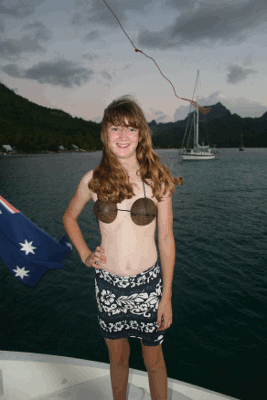
|
|||||

|
Nick, not being one to be left out decided to front up and try on the new “Titi-Coco” bra himself. The skirt was a nice touch and the colours really brought out the blue of his eyes. Cheryl had a turn next, but I wasn't allowed to publish that photo – I think we needed larger coconuts. I couldn't be left out of the fun, so I tried on the new toy and was amazed to find the “titi-coco” quite comfortable and supportive, perhaps I should have bought one too? |
|||||
|
Tuesday 26th July 2011 After a pleasant overnight sail from Moorea, we arrived in Bora Bora around lunch time and picked up a mooring ball at the new Maiaki Marina which is just off the main town. Bora Bora is the most beautiful island we've visited yet. I know I keep saying this of every island we visit, but honestly, they just keep getting better and better as we sail through the Pacific. The whole island is inside an almost continuous fringing reef that protects the island from the swell of the ocean and because of this it makes the waters inside the reef crystal clear. The fringing sandy motus stand out like gold against the beautiful blue of the water and the lush green of the island. Just behind our mooring and behind the main town of Viatape we can see the ragged and fearsome outline of Mt. Pahia which climbs steeply up 661m above the coast. |
||||||
|
We figured that the best way to see the island was to do a walk, so we buddied up with “Steel Sapphire” and hiked up Mt Pahia. The sign at the beginning of the walk said that it was strongly recommended that we take a local guide as the hike was very rugged and dangerous. Being Aussies we figured we were ok, so we took it on notice and continued without a local guide – we've done lots of hiking in some pretty rugged places before. The hike was amazing once we got under the canopy of the rainforest and the temperature dropped a few degrees which was welcomed. The walk, or should I say, the climb was breathtaking in more ways than one. In places, the trail got so steep that there were ropes, of varying dubious condition, that hung down the tricky sections of the trail to help you climb. |
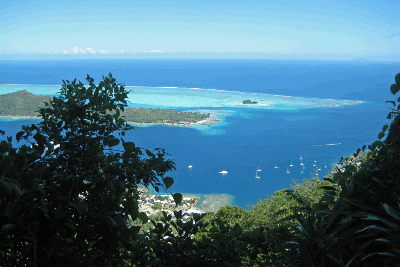
|
|||||
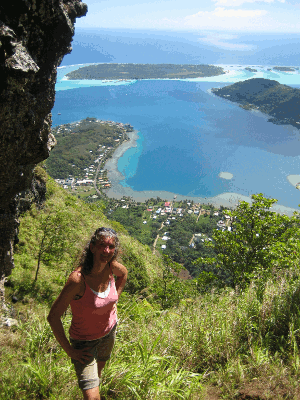
|
We slowly made our way up the mountain and every time we hiked past a clearing in the canopy the view of Bora Bora and the fringing reef just became more and more magical. We hiked until we could see the circle of reef surrounding the island and could gaze down into the tranquil cool waters of the island. By this time our position on the mountain was on the sunny side and the rock was black and radiating heat back at us – how we wished we were down there in the beautiful cool water. I'd have liked to say we made it all the way to the top of the mountain, but we didn't. Our children had mutineered on us a little earlier, complaining of worn out their feet they'd sat down with Glenn and were refusing to go any further. Cheryl and I continued on for another 10 minutes or so and hiked to a particularly steep section where we could see that we still had about 50m of steep climbing to get to the top of the mountain, then a walk across the spine to the peak. Figuring it wouldn't take less than another 40minutes to get to the top, and having drunk all our water, we sat and enjoyed the view for a few minutes as we got our breath back, then reluctantly turned around made our way back to our little group, then back down the mountain. |
|||||
|
Most days in town we could hear beautiful traditional drumming and music coming from what looked like a community hall. As we walked into town and back again we could see dancers practising inside. Curiosity eventually got the better of me and we decided to walk up and have a better look. Inside the hall in one corner was a group of musicians playing drums, ukulele's and guitars. Their music was inspiring and they all played with enthusiasm, their smiles and movements making it clear that they were enjoying themselves. From time to time one would poke another or make a quip that would bring laughter from the group. In the middle of the hall were lines of ladies practising dances for an upcoming festival. Although none of them were in uniform, just watching them move was an experience and it wasn't hard to picture how entrancing these dances would have been generations ago, as they told stories of their people and their history. Of all the dancers practising, it was the older, more voluptuous women who were the most outstanding. Despite their age and their additional curves, they were flexible and fast! We watched, entranced, as they danced their stories, moving their hands and flashing their hips from side to side; had they been wearing skirts rather than their casual clothing, the skirts themselves would have been flying out in an array of colour, accentuating their hips and their dances. The ladies were also smiling and enjoying their time with their friends. The atmosphere was light and happy and charged with energy. We sat and watched the women dance for a while, as we absorbed the music and the scene around us. Sitting between some of the older matriarchs of the island, we listened and watched as they pointed out various dancers and made subtle comments with smiles on their faces. The whole atmosphere was light and merry and we felt like we were right in the middle of island life. We live for the moments when we feel that we're a part of the local's life, rather than being seen as a tourist. This was one such moment. |
||||||
|
Saturday 30th July 2011 Steve and Dean from the Australian boat “Mamalu” invited us to join them for a snorkelling trip around the far end of the island. Since our dinghy still wasn't working, we gratefully accepted and all piled into their dinghy. The ride out was exhilarating – their dinghy is so much better than ours, the deep V of the aluminium bottom split the seas with ease and the large outboard powered us all through the swell at great speed. How can I explain it: their dinghy was like a new Hummer, solid and powerful, ours on the other hand was like a … well ours was like a 1963 Skoda. Yeah – I was experiencing dinghy envy!!!! |
||||||
|
Around the back of the island, we donned our dive gear and jumped into the water to snorkel the reef. The water was deeper than we'd thought, 10-15m on average, but as we swam out over the edge of the reef we saw a couple of Spotted Eagle Rays slowly making their way across the bottom. The water here was so clear that it looked like they were gliding through air, flying over the sand. As we floated above the rays, we noticed another school swimming towards the first. We watched in amazement as yet a third school of rays merged into the group. At one stage I counted 32 Spotted Eagle Rays gliding below us. The scene was incredible. I dove down to join the school of rays a number of times; staying down until my lungs were near breaking. I couldn't get enough of this amazing world. If watching the ladies practising their dancing made us feel a part of the Bora Bora community, diving with the Spotted Eagle Ray school made me feel a part of this underwater paradise. I could almost imagine I was a ray, swimming with the other 30 rays, making my way slowly above the sandy bottom, gliding in the light current and the warm waters – not a care in the world. |

|
|||||
|
|
||||||
|
|
|
|||||
|
|
||||||
|
|
|
|||||
|
|
||||||
|
|
||||||
|
|
||||||
